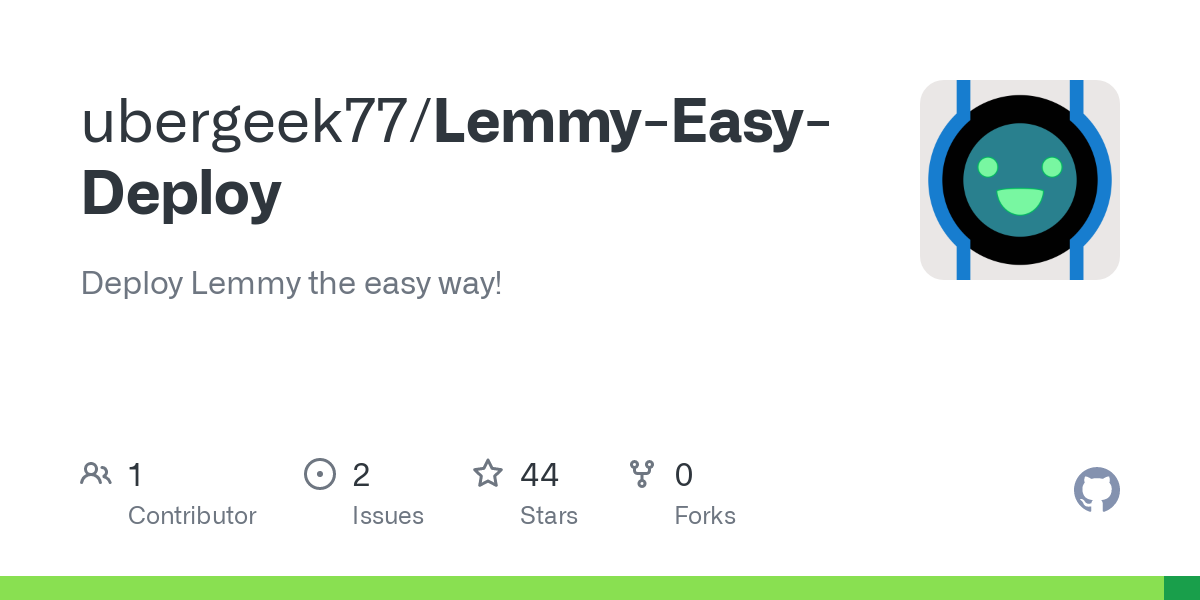In the past few days, I’ve seen a number of people having trouble getting Lemmy set up on their own servers. That motivated me to create Lemmy-Easy-Deploy, a dead-simple solution to deploying Lemmy using Docker Compose under the hood.
To accommodate people new to Docker or self hosting, I’ve made it as simple as I possibly could. Edit the config file to specify your domain, then run the script. That’s it! No manual configuration is needed. Your self hosted Lemmy instance will be up and running in about a minute or less. Everything is taken care of for you. Random passwords are created for Lemmy’s microservices, and HTTPS is handled automatically by Caddy.
Updates are automatic too! Run the script again to detect and deploy updates to Lemmy automatically.
If you are an advanced user, plenty of config options are available. You can set this to compile Lemmy from source if you want, which is useful for trying out Release Candidate versions. You can also specify a Cloudflare API token, and if you do, HTTPS certificates will use the DNS challenge instead. This is helpful for Cloudflare proxy users, who can have issues with HTTPS certificates sometimes.
Try it out and let me know what you think!
Really awesome work. We need more Lemmy servers!
As someone who spent hours figuring out how to deploy through Ansible, how dare you /s But seriously thank you for putting in the work to make creating an instance more attainable for people.
This was the only tool that I was able to get running. I recommend it to anyone curious about running their own instance. I tried both the official Ansible and Docker instructions, and neither worked.
I used this and the developer is very helpful. Works great. Helped me even upgrade to 0.18.0.
After trying to do it with docker or ansible manually for hours and failing, this was soo helpful. So thank you.
The check
$LEMMY_HOSTNAME == http*will give a false positive if (for whatever reason) the domain name starts with httpThanks! Fix pushed.
Wow, I’ll definitely look into this, thanks! Even if I don’t use it, it still may be useful just reading through it.
You kind Sir/Lady/Gentleperson are making the fediverse a better place with this help. Thanks a bunch, gonna definitely ease my attempts at eventually self-hosting!
I will definitely try this out. I already have my domain and SSL certificate. This will work on linode right?
It will work on pretty much anything that has a public IP and a domain pointing to that IP. The only thing that won’t work “out of the box” for most users is email, as most VPS providers block port 25. If you’ve requested access to port 25 and have been approved to use it, you can edit
config.envto turn on the email service.As for your SSL certificate, unfortunately this does not support importing your own certificate. It’s made for beginners, after all :p
But there should be no problems with Caddy simply requesting a new one for you!
Email is vital to lemmy working. Saying this works without mail config is just silly.
I’m not sure what you mean? Most people are just self hosting instances for themselves, where email isn’t needed. My instance doesn’t have an email service.
And as I explained, if email is something you want, I have an advanced option for this. It’s not the default because there is not a public VPS host out there that lets you use port 25 without special approval.
Email config is needed for lost passwords. It’s also needed for account verification, if you run without verification you could easily become a place for people to abuse other servers and get yourself defederated.
Many web hosts have poisoned mail IPs, so setting up with a smtp config to a well known site server is required if you want your emails to be delivered.
And that is why I don’t advertise this as supporting email out of the box, and why it’s an advanced option without any support from me. The embedded postfix server is part of the official Docker Compose deployment from upstream Lemmy, and it’s part of the officially supported Ansible deployment too. Those deployment methods are what this is modeled after. That is as far as I go on email support. If upstream Lemmy started including some automatic AWS SNS configuration, I would adopt it, but they have not done so.
Everyone who has reported success to me so far are running single user instances for themselves. That is my target audience, and for that audience (and myself), email is not even close to being a hard requirement.
However, if you would like to improve this script by adding support for more robust and secure email systems, I would be happy if you submitted a PR to do just that :)
Don’t lose your passwords and leave closed registration so only people you actually want on your instance are on it. You absolutely do not need email.
You can’t have the checkbox for federation and private, the server will crash and tell you that in the lemmy log. Had that happen when I did thy to setup without email the first time.
how well do those email servers work to begin with? i just flat out disabled the postfix relay on my instance and simply configured sendgrid, which works perfectly, no delays or spam folder issues (although i did have to disable a bunch of tracking bullshit). doing so with similar services has been my go-to card in freelance webdev, because getting other mail servers to trust you can be hard, so i’m interested in the experience people are having with those. (i’d much prefer to self-host email too, but providing a good experience is the primary goal)
I haven’t actually used the embedded postfix server at all, I keep mine disabled. I only include it because it’s “included” in the official Docker deployment files, and I try to keep this deployment as close to that as possible.
I’m considering adding support for an external email service, as you mentioned, but I have nearly zero experience in using managed email services, and I’m not sure if non-technical users would be able to navigate the configuration of things I can’t do for them (i.e. on a web dashboard somewhere). And if I can’t do it for them, it means more issues for me, so I hesitate to add support for it at all.
I’d love to hear your experience in setting up sendgrid and how easy that was. And the tracking stuff you mentioned as well.
On the surface, setting up an external mail server is actually super easy. Pretty much every service supports SMTP, so all you need is to find your credentials (an endpoint, a username, and a password) and input that in your lemmy.hjson file, along with a sender address. There is a verification process with every email provider, you will usually have to set some DNS records to prove you own the domain you’re trying to send from, but once you do these two things, emails will just start flying out.
The actual process tends to be a little more tedious though. Pretty much every mail provider wants to sell you on their specific super awesome API and only mentions SMTP as a footnote, for reasons that I can only parse as an attempted vendor lock-in. They also sometimes make the verification process difficult. SendGrid, for example, immediately redirects you to their “sender identities” which are more useful for their marketing automation tooling than they are for automated emails from a website, and you also have to dig a fair bit to find the SMTP credentials. (The endpoint is
smtp.sendgrid.net,apikeyon the username, and whatever your API key is for the password, you’ll need to set one of those up.) They also have a number of different tracking things that you’ll have to find and turn off in the UI (luckily all of them can be toggled in the same place), which would normally actually help you by providing you statistics about how many emails were opened and how many people clicked on links, but for the emails Lemmy sends, it’s useless and I didn’t want SendGrid to collect that data on my instance users, so I shut that off.Initially, I wanted to use Amazon SES, but they have an even more tedious setup: you have to talk to an actual human to have them turn it on for you, otherwise you’re stuck in sandbox mode and can only send email to verified receiver addresses. Their service works well though, I used it a lot in my freelancer days, and they do make it fairly straightforward to find the SMTP credentials, but the verification process can be slow.
I also remember using Mailgun for some project ages ago, it was pretty much the same deal as all the others: you have to pry the SMTP details out of their docs, but once you do and you verify your stuff, it works well.
Ultimately, I think the best you could do to help out users here is to provide them with documentation for a few of these services: exactly where to go, which buttons to click and whatnot. Or just stick to the embedded service for a bit, but the real issue there is the bounce rates from spammers. They made my instance send out like 60-70 verification emails for bogus addresses on gmail, yahoo, hotmail, and live.com on the first day I got federation working, and if you don’t already have a good reputation – which is what these third parties help you with – then you can easily get yourself blacklisted, either internally or externally.
I see. Thanks a lot for this!
I really don’t have the capacity to support a bunch of different email services, so it sounds like the best I can do right now is make the SMTP settings accessible without also running the postfix server. So if someone wants to run their own email somewhere else, they can configure it. But otherwise, I’ll leave it to the user to figure out what happens after an email request leaves Lemmy.
Does that sound fair, and like something you would have used? Essentially just an interface in
config.envthat puts the right SMTP address/credentials inlemmy.hjson.yup, that sounds perfect
i can’t track down a non vendor-specific guide right now but if you just expose the same settings in
config.envthat you’d have in thelemmy.hjsonfile that should be more than sufficient to get an external service goingThanks!
I’ve got that included in a staging version I’m preparing to release, if you wanted to take a look at the changes:
Literally been thinking about this so thank you beautiful brained individual. Would you mind if I shouted this in the YSK group?
Thank you very much for the kind words!
Please be my guest! It would make me happy to know this was helping people join Lemmy!
Marius Hosting published a good guide this week that I used on my nas without an issue (via docker compose).
Looks great my dude.
If you expanded out the environment variables a ton, making it more customizable, (with default values in place of couse) this could appeal to a huge range of people.Exploring Go High Level:
What’s the Enthusiasm About?
Hello there! Are you familiar with Go High Level? If not, let’s break it down. Imagine managing multiple apps for marketing. Sounds busy. That’s where Go High Level comes in. It’s like that friend who has a solution for everything. Whether you are working on creating an outstanding sales funnel or sending out an email campaign, this platform has your back. The best part? They let you test drive everything with a 14-day free trial. It’s like trying out a new car but for your business. And if you ever need assistance, their support team is just a click away. Pretty exciting, huh?So, How Much Does It Cost?
Alright, let’s talk about the financial side. Go High Level offers 3 main plans. The Agency Starter Plan is perfect if you’re just starting or have a small business. It’s loaded with all the essential tools, and it’s quite cost-effective. But if you’re looking to scale up, the Agency Unlimited Plan is your best choice. It’s like the VIP pass at a concert, giving you access to everything without any limitations. Not sure about committing? Remember that 14-day free trial I mentioned? It’s a great way to give it a try without any obligations. Lastly, they offer a Pro plan that includes “SaaS mode,” where you can white label the product under your brand. Fantastic!Why Everyone’s Raving About It:
In a world full of sophisticated digital tools, Go High Level is like that all-in-one Swiss Army knife. There’s no need to switch between apps because it has everything under one roof. Whether you’re a newcomer or an experienced marketer, it’s super user-friendly. It’s not just about launching impressive campaigns; they ensure you understand their performance with top-notch analytics. There’s even a white-label feature for marketing agencies, so you can add your brand and impress your clients.Here is a link to their 14-day free trial:
https://www.gohighlevel.com/?fp_ref=get-started-now.Nice! Looks like it even has update checker as well. Is there any reason why
pictrsis not included in the update checker and hardcoded to version 0.3.1?The Lemmy maintainers themselves seem to lock it at 0.3.1, and I wanted to maintain parity with their deployment. I know
pictrsis up to at least0.3.3, and has a release candidate for0.4, but upstream Lemmy uses0.3.1for whatever reason, so that’s why I lock it there.It’s excluded from the update checker because I don’t have a stable way to check what version upstream is using. The Lemmy update checker just checks to see what the latest tag on
LemmyNet/lemmyis. I could try and pull the latest Gitea tag forpictrs, but since upstream Lemmy isn’t using the latest version, that’s not really an option as something might break.I considered trying to parse their docker-compose.yml file to see what version they use, but they seem to be restructuring their
dockerfolder right now. The folder inmainis completely different from the one tagged0.17.4. If I assume a certain directory path for that file for every version after this, but they move it, my script will break. Sadly, until their Docker deployment files seem like they’re going unchanged for a good few versions, I’ll have to do it manually for now.I see, looks like it’s a correct decision to me. Let the Lemmy developers worry about which version of pictrs to use themselves.
I’m relatively competent installing server software, but the Lemmy instructions completely flummoxed me. Their docker instructions just don’t work.
I ended up using the ansible docker scripts and filling out the blanks because I’m unfamiliar with ansible.
If this is as good as it sounds, you’re doing everyone a massive favour.
deleted by creator














